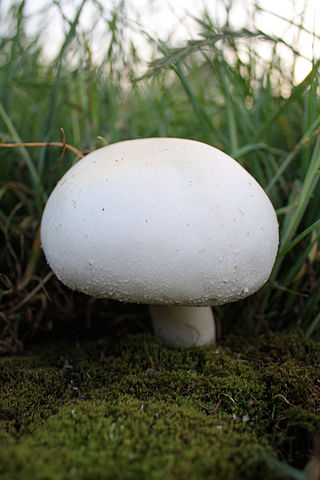Top Qs
Timeline
Chat
Perspective
Agaricus arvensis
Species of fungus From Wikipedia, the free encyclopedia
Remove ads
Agaricus arvensis, commonly known as the horse mushroom,[2] is a mushroom-forming fungus of the genus Agaricus.
Remove ads
Taxonomy
It was described as Agaricus arvensis by Jacob Christian Schaeffer in 1774,[3] and given numerous binomial descriptions since. Its specific name arvensis means "of the field".
Description

The cap is 7–20 cm (3–8 in) across, whitish, smooth, and dry; it stains yellow, particularly when young.[4] The gills are pale pink to white at first, later passing through grey and brown to become dull chocolate.[4] A large, spreading ring has white above, but sometimes with yellowish scales underneath. Viewed from below, on a closed-cap specimen, the twin-layered ring has a well-developed "cogwheel" pattern around the stipe. This is the lower part of the double ring. The stalk is 5–12 cm (2–4+1⁄2 in) long and 1–3 cm wide.[4]
The spores are brown and smooth,[4] producing a dark brown spore print.[5] Its odor is similar to that of almond extract or marzipan, due to the presence of benzaldehyde.[6] It tends to stain yellow on bruising.[7]
Similar species
In addition to its similarity to other related species,[5] this fungus can be confused with deadly species of Amanita.[8]
Agaricus osecanus is rare, and lacks the almond smell.[9] Agaricus xanthodermus, the yellow stainer, can cause stomach upsets.[4]
Remove ads
Distribution and habitat
It is one of the largest white Agaricus species in Britain (where it appears during July–November), West Asia (Iran),[10] and North America.
Frequently found near stables, as well as in meadows, it may form fairy rings. The mushroom is often found growing with nettles (a plant that also likes nutrient-rich soil).[citation needed] It is associated with cypress on the North American West Coast and spruce to the east.[5]
Conservation
This mushroom is considered common and widespread, thus is not a conservation concern.[11]
Edibility
This is a choice edible species.[12][7] Despite this, the fruit bodies of this and other yellow-staining Agaricus species often have a build-up of heavy metals, such as cadmium, and copper.[11] Additionally, this mushroom can resemble deadly Amanita mushrooms, such as A. verna.[8]
References
External links
Wikiwand - on
Seamless Wikipedia browsing. On steroids.
Remove ads


